Assessing the Performance of WRF Model in Simulating Heavy Precipitation Events over East Africa Using Satellite-Based Precipitation Product
Abstract
:1. Introduction
2. Materials and Methods
2.1. Study Area, and Heavy PRE Event Selection and Verification
2.2. Observation and Model Data
| Type of Dataset | Spatial Resolution | Temporal Resolution | Source | Downloadable at | |
|---|---|---|---|---|---|
| Satellite | PERSIANN-CCS-CDR | 0.04° × 0.04° | Daily | [52] | [47] |
| GPM IMERG | 0.1° × 0.1° | Daily | [29] | [53] | |
| CHIRPS | 0.05° × 0.05° | Daily | [28] | [54] | |
| TAMSAT | 0.0375° × 0.0375° | Daily | [26] | [46] | |
| WRF | D01 D02 D03 | 0.405° × 0.376° 0.135° × 0.132° 0.045° × 0.045° | 3-hourly | [11] | [39] |
| Reanalysis | ERA5 | 0.25° × 0.25° | 6-hourly | [51] | [38] |
2.3. Model Description and Experimental Design
2.4. Synoptic Analysis of Severe Weather Events
2.4.1. Wind Circulation
2.4.2. Relative Humidity (RH)
2.4.3. Precipitable Water (PW)
2.4.4. Convective Available Potential Energy (CAPE)
2.4.5. K-Index
2.4.6. Total of Totals Index (TTs)
3. Results
3.1. Spatial and Temporal Validation of Satellites PRE Datasets against Station Data
3.1.1. Mean Annual Cycle of PRE
3.1.2. Performance of Satellite Data against Gauge Stations
3.2. Comparison of Heavy PRE from WRF and Satellite Estimates
3.2.1. Case 1 (8 June 2020)
3.2.2. Case 2 (10 June 2020)
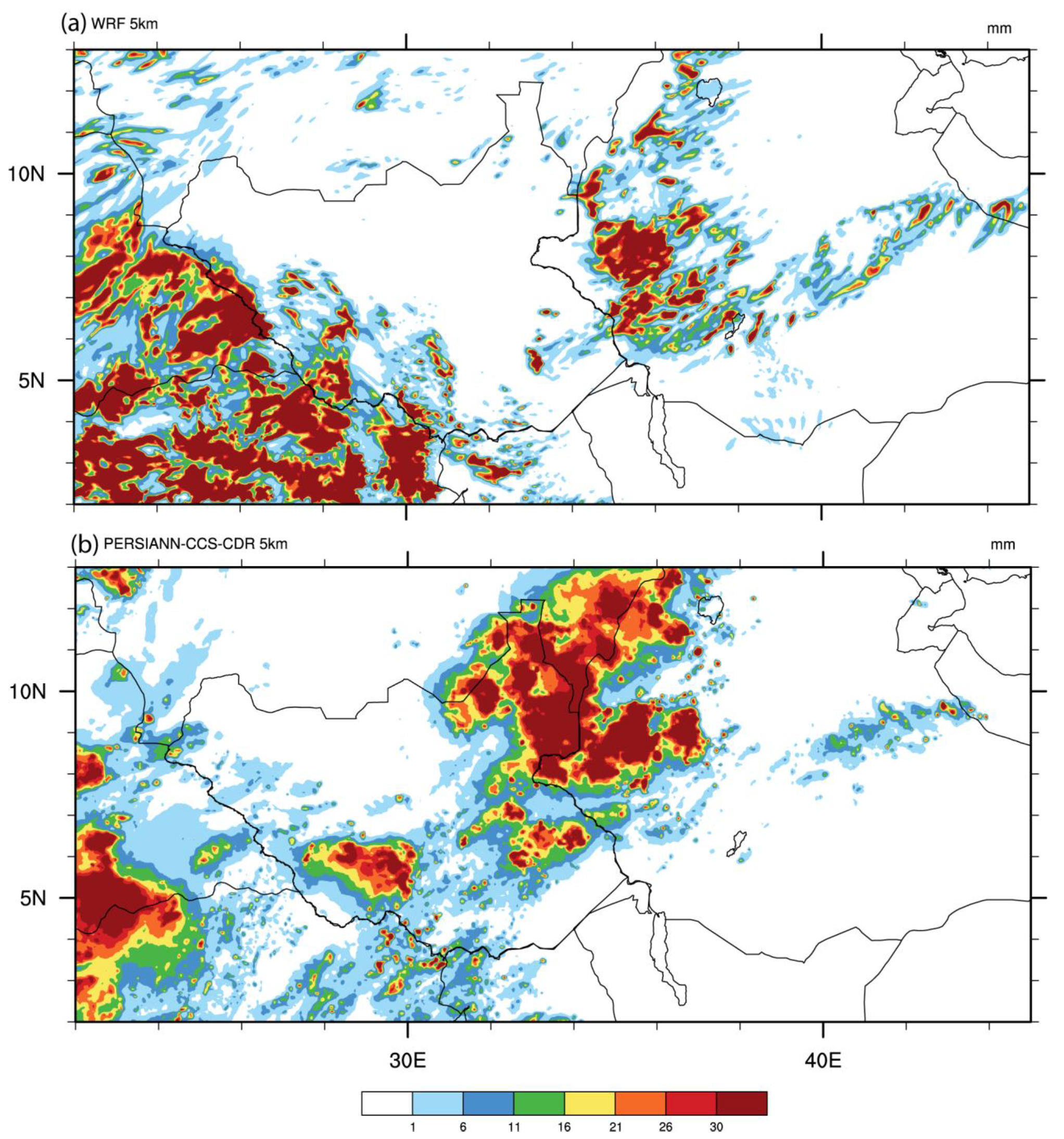
3.2.3. Case 3 (18 June 2020)
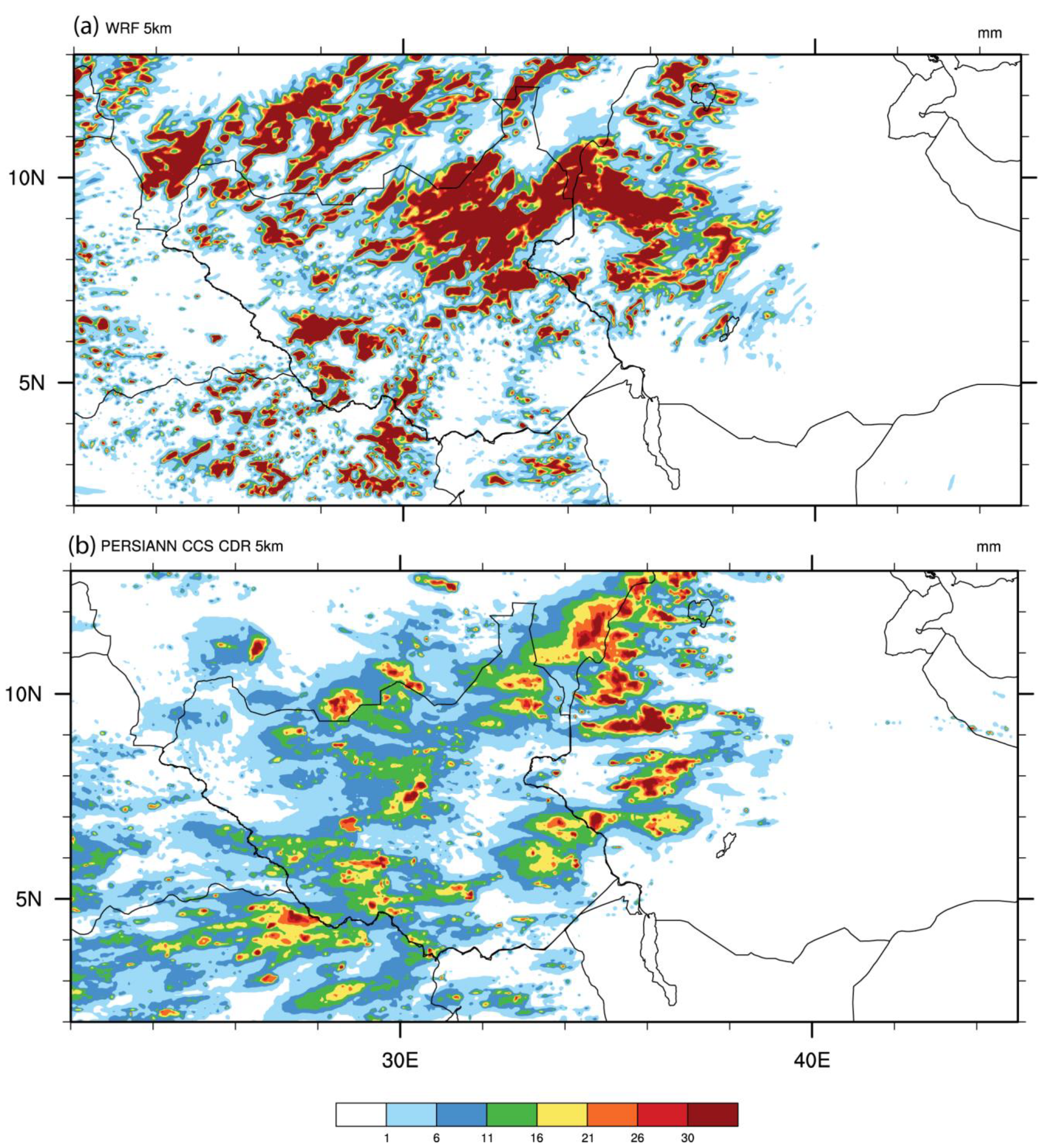
3.2.4. Case 4 (20 July 2020)
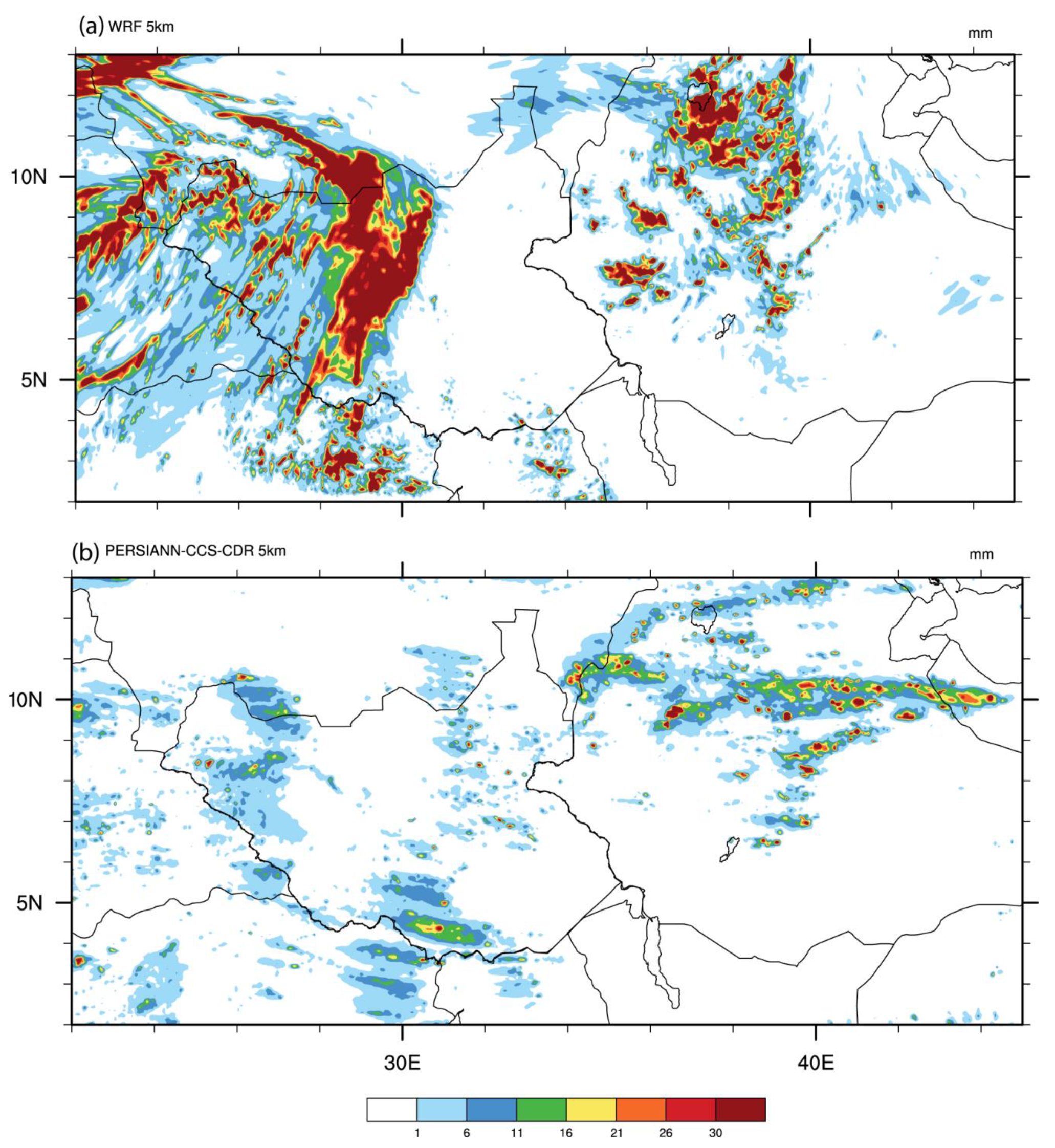
3.2.5. Case 5 (27 August 2020)

3.3. Synoptic Conditions during Heavy PRE Events

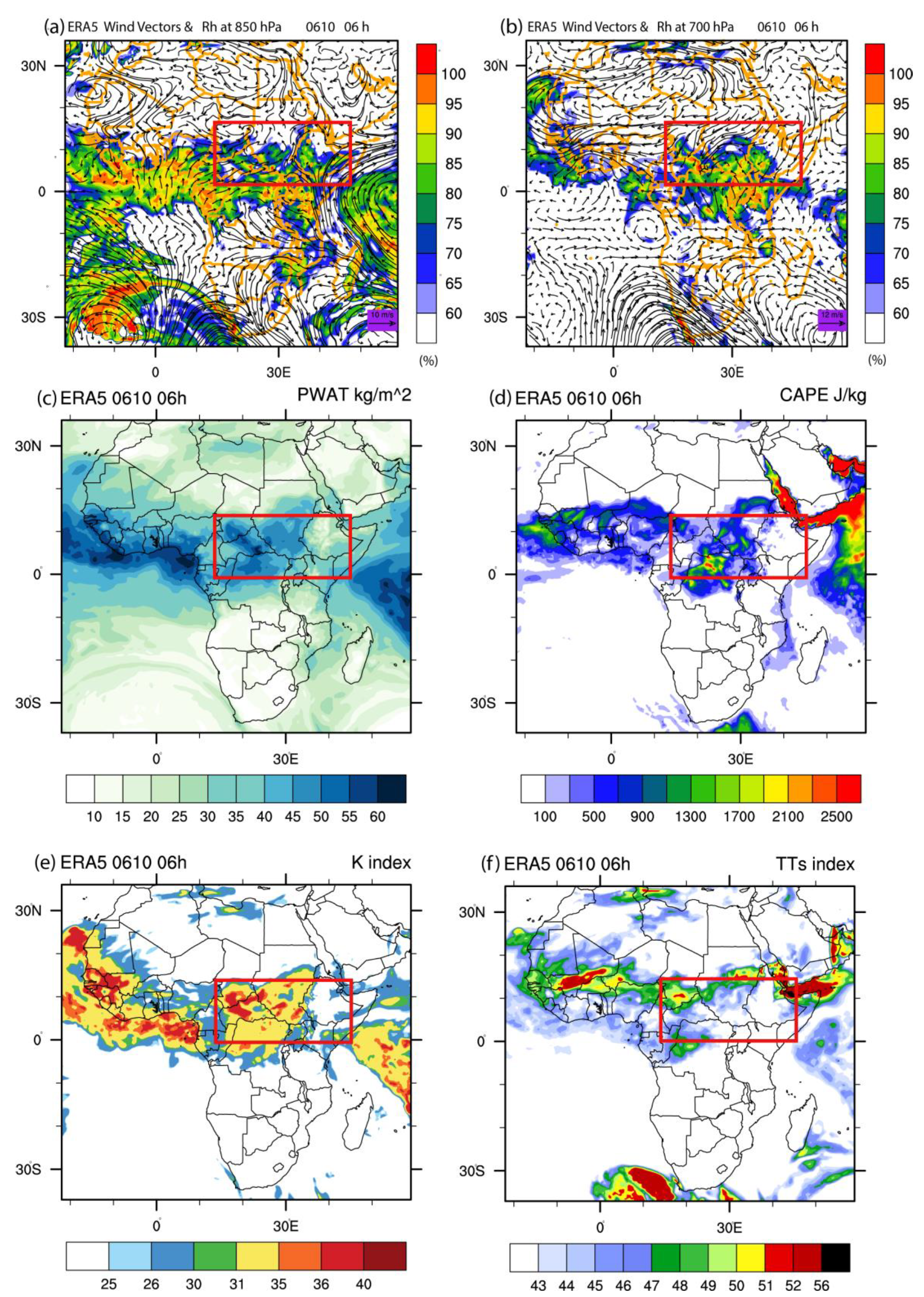
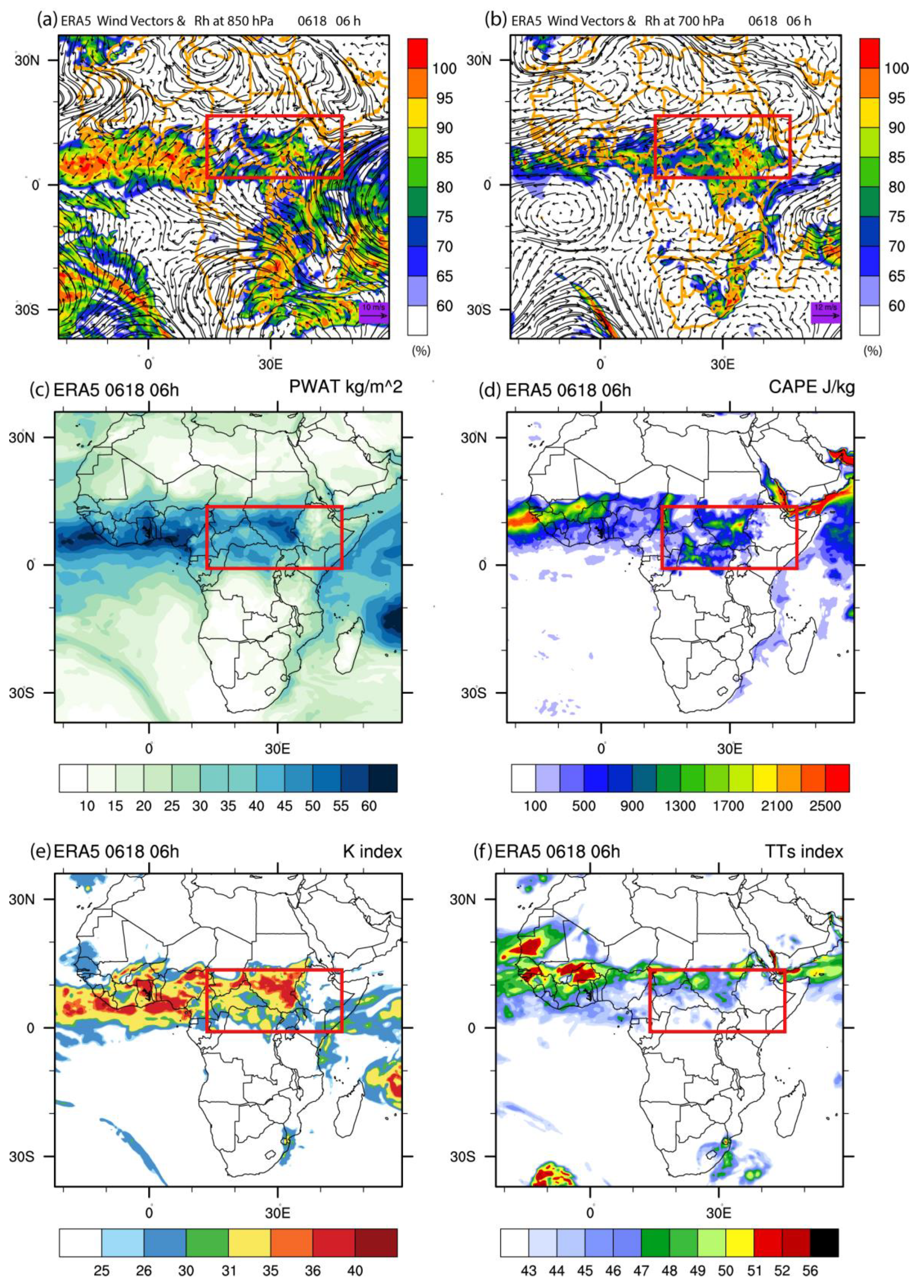
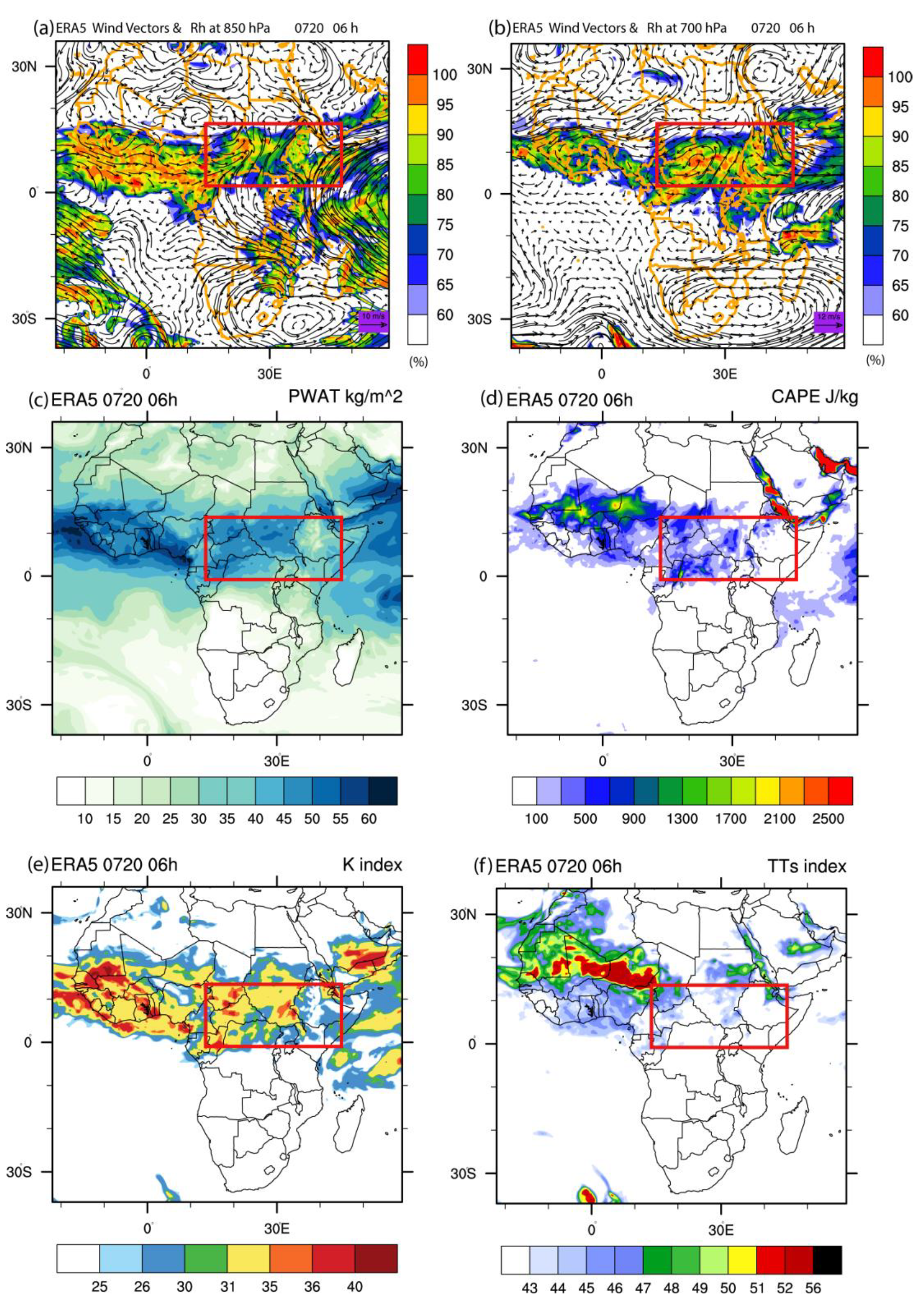
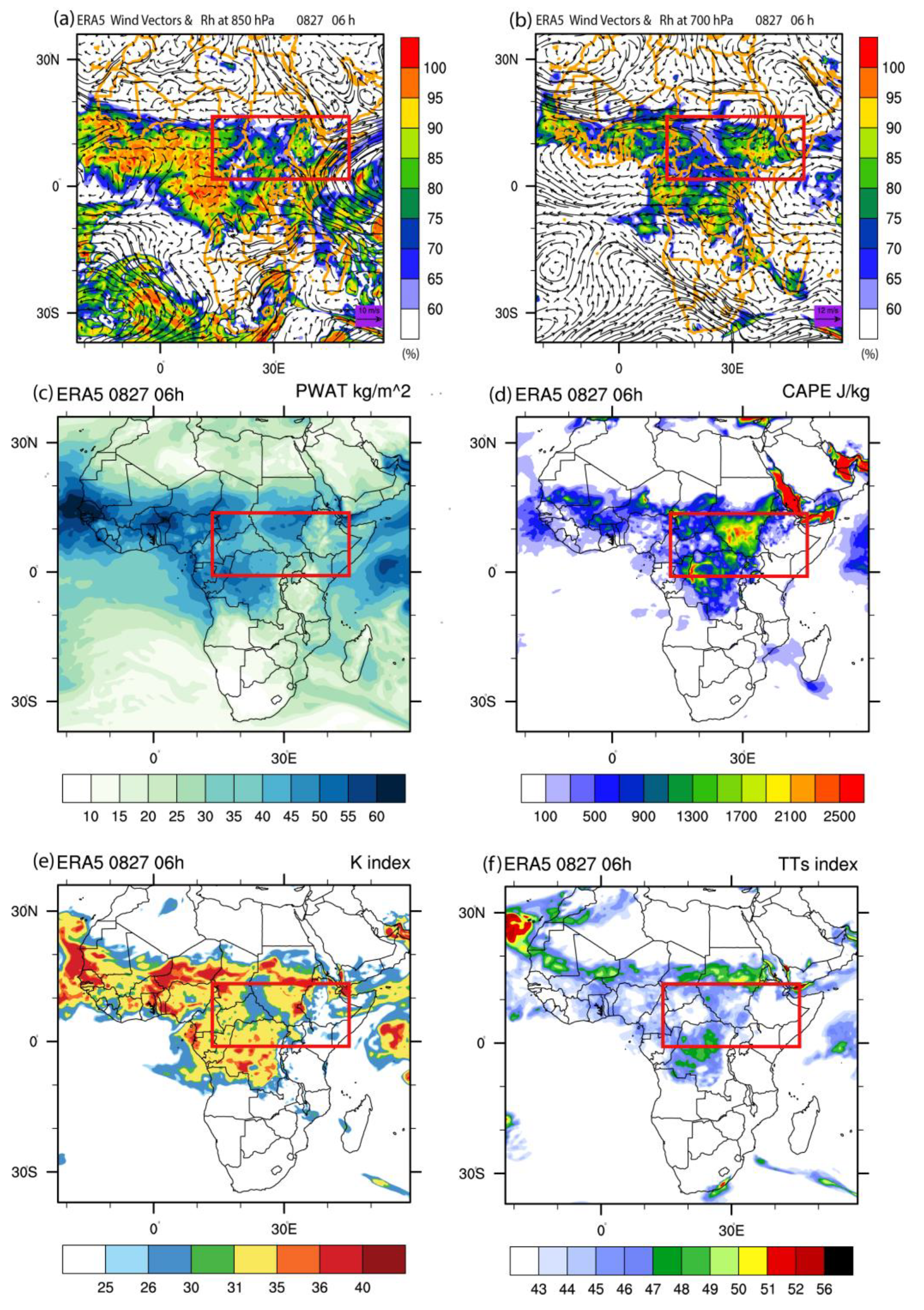
4. Discussions
5. Conclusions
Supplementary Materials
Author Contributions
Funding
Data Availability Statement
Acknowledgments
Conflicts of Interest
References
- IPCC. Summary for Policymakers. In Climate Change 2021: The Physical Science Basis. Contribution of Working Group I to the Sixth Assessment Report of the Intergovernmental Panel on Climate Change; Cambridge University Press: Cambridge, UK, 2021. [Google Scholar]
- FLOODLIST. Home Page. Available online: http://floodlist.com/africa/ (accessed on 12 December 2021).
- EM-DAT. International Disaster Database Home Page. Available online: https://emdat.be/ (accessed on 12 December 2021).
- Mensah, H.; Ahadzie, D.K. Causes, impacts and coping strategies of floods in Ghana: A systematic review. SN Appl. Sci. 2020, 2, 792. [Google Scholar] [CrossRef] [Green Version]
- United Nation Economic Commission for Africa. New and Emerging Challenges in Africa Summary Report; UNECA: Addis Ababa, Ethiopia, 2011. [Google Scholar]
- United Nations Office for Disaster Risk Reduction. Disaster Risk Reduction and Resilience in the 2030 Agenda for Sustainable Development; UNDRR: Geneva, Switzerland, 2015. [Google Scholar]
- Nkwunonwo, U.C.; Whitworth, M.; Baily, B. A review of the current status of flood modelling for urban flood risk management in the developing countries. Sci. Afr. 2020, 7, e00269. [Google Scholar] [CrossRef]
- Li, C.J.; Chai, Y.Q.; Yang, L.S.; Li, H.R. Spatio-temporal distribution of flood disasters and analysis of influencing factors in Africa. Nat. Hazards 2016, 82, 721–731. [Google Scholar] [CrossRef]
- World Meteorological Organization. WMO Statement on the State of the Global Climate in 2018; World Meteorological Organization: Geneva, Switzerland, 2018. [Google Scholar]
- Ebert, E.E.; Janowiak, J.E.; Kidd, C. Comparison of Near-Real-Time Precipitation Estimates from Satellite Observations and Numerical Models. Bull. Am. Meteorol. Soc. 2007, 88, 47–64. [Google Scholar] [CrossRef] [Green Version]
- Skamarock, C.; Klemp, B.; Dudhia, J.; Gill, O.; Liu, Z.; Berner, J.; Wang, W.; Powers, G.; Duda, G.; Barker, D.M.; et al. A Description of the Advanced Research WRF Model Version 4; National Center for Atmospheric Research: Boulder, CO, USA, 2019. [Google Scholar]
- Coiffier, J. Fundamentals of Numerical Weather Prediction; Cambridge University Press: Cambridge, UK, 2011. [Google Scholar]
- Sun, X.; Xie, L.; Semazzi, F.; Liu, B. Effect of Lake Surface Temperature on the Spatial Distribution and Intensity of the Precipitation over the Lake Victoria Basin. Mon. Weather. Rev. 2015, 143, 1179–1192. [Google Scholar] [CrossRef]
- Meroni, A.N.; Oundo, K.A.; Muita, R.; Bopape, M.-J.; Maisha, T.R.; Lagasio, M.; Parodi, A.; Venuti, G. Sensitivity of some African heavy rainfall events to microphysics and planetary boundary layer schemes: Impacts on localised storms. Q. J. R. Meteorol. Soc. 2021, 147, 2448–2468. [Google Scholar] [CrossRef]
- Nkunzimana, A.; Bi, S.; Alriah, M.A.A.; Zhi, T.; Kur, N.A.D. Diagnosis of meteorological factors associated with recent extreme rainfall events over Burundi. Atmos. Res. 2020, 244, 105069. [Google Scholar] [CrossRef]
- World Meteorological Organization. Chapter 14. Observation of present and past weather; state of the ground. In Guide to Meteorological Instruments and Methods of Observation; World Meteorological Organization: Geneva, Switzerland, 2018; pp. 14–19. [Google Scholar]
- Nicholson, S.E.; Klotter, D.; Zhou, L.; Hua, W. Validation of Satellite Precipitation Estimates over the Congo Basin. J. Hydrometeorol. 2019, 20, 631. [Google Scholar] [CrossRef] [Green Version]
- Musonda, B.; Jing, Y.; Nyasulu, M.; Mumo, L. Evaluation of sub-seasonal to seasonal rainfall forecast over Zambia. J. Earth Syst. Sci. 2021, 130, 47. [Google Scholar] [CrossRef]
- Adjei, K.A.; Ren, L.; Appiah-Adjei, E.K.; Odai, S.N. Application of satellite-derived rainfall for hydrological modelling in the data-scarce Black Volta trans-boundary basin. Hydrol. Res. 2014, 46, 777–791. [Google Scholar] [CrossRef]
- van de Giesen, N.; Hut, R.; Selker, J. The Trans-African Hydro-Meteorological Observatory (TAHMO). Wiley Interdiscip. Rev. Water 2014, 1, 341–348. [Google Scholar] [CrossRef] [Green Version]
- Nicholson, S.E. The Predictability of Rainfall over the Greater Horn of Africa. Part II: Prediction of Monthly Rainfall during the Long Rains. J. Hydrometeorol. 2015, 16, 2001–2012. [Google Scholar] [CrossRef]
- European Space Agency. Europe’s Copernicus Programme. Available online: https://www.esa.int (accessed on 2 June 2021).
- NASA. Home Page. Available online: http://www.nasa.gov/home/index.html (accessed on 12 December 2021).
- Sun, Q.; Miao, C.; Duan, Q.; Ashouri, H.; Sorooshian, S.; Hsu, K.-L. A Review of Global Precipitation Data Sets: Data Sources, Estimation, and Intercomparisons. Rev. Geophys. 2018, 56, 79–107. [Google Scholar] [CrossRef] [Green Version]
- Le Coz, C.; van de Giesen, N. Comparison of Rainfall Products over Sub-Saharan Africa. J. Hydrometeorol. 2020, 21, 553–596. [Google Scholar] [CrossRef]
- Maidment, R.I.; Grimes, D.; Black, E.; Tarnavsky, E.; Young, M.; Greatrex, H.; Allan, R.P.; Stein, T.; Nkonde, E.; Senkunda, S.; et al. A new, long-term daily satellite-based rainfall dataset for operational monitoring in Africa. Sci. Data 2017, 4, 170063. [Google Scholar] [CrossRef] [PubMed]
- Ashouri, H.; Hsu, K.-L.; Sorooshian, S.; Braithwaite, D.K.; Knapp, K.R.; Cecil, L.D.; Nelson, B.R.; Prat, O.P. PERSIANN-CDR: Daily Precipitation Climate Data Record from Multisatellite Observations for Hydrological and Climate Studies. Bull. Am. Meteorol. Soc. 2015, 96, 69–83. [Google Scholar] [CrossRef] [Green Version]
- Funk, C.; Peterson, P.; Landsfeld, M.; Pedreros, D.; Verdin, J.; Shukla, S.; Husak, G.; Rowland, J.; Harrison, L.; Hoell, A.; et al. The climate hazards infrared precipitation with stations—A new environmental record for monitoring extremes. Sci. Data 2015, 2, 150066. [Google Scholar] [CrossRef] [Green Version]
- Huffman, G.J.; Bolvin, D.T.; Braithwaite, D.; Hsu, K.; Joyce, R.; Kidd, C.; Sorooshian, S.; Xie, P.; Yoo, S.-H. Developing the Integrated Multi-satellitE Retrievals for GPM (IMERG). Acta Paul. Enferm. 2012, 25, 146–150. [Google Scholar]
- Nicholson, S.E.; Klotter, D.A.; Dezfuli, A.K.; Zhou, L.G. New Rainfall Datasets for the Congo Basin and Surrounding Regions. J. Hydrometeorol. 2018, 19, 1379–1396. [Google Scholar] [CrossRef]
- Ayugi, B.; Tan, G.; Ullah, W.; Boiyo, R.; Ongoma, V. Inter-comparison of remotely sensed precipitation datasets over Kenya during. Atmos. Res. 2019, 225, 96–109. [Google Scholar] [CrossRef]
- Dinku, T.; Ceccato, P.; Grover-Kopec, E.; Lemma, M.; Connor, S.J.; Ropelewski, C.F. Validation of satellite rainfall products over East Africa’s complex topography. Int. J. Remote Sens. 2007, 28, 1503–1526. [Google Scholar] [CrossRef]
- Logah, F.Y.; Adjei, K.A.; Obuobie, E.; Gyamfi, C.; Odai, S.N. Evaluation and Comparison of Satellite Rainfall Products in the Black Volta Basin. Environ. Process. 2021, 8, 119–137. [Google Scholar] [CrossRef]
- Dembélé, M.; Zwart, S.J. Evaluation and comparison of satellite-based rainfall products in Burkina Faso, West Africa. Int. J. Remote Sens. 2016, 37, 3995–4014. [Google Scholar] [CrossRef] [Green Version]
- Diongue, A.; Lafore, J.-P.; Redelsperger, J.-L.; Roca, R. Numerical study of a Sahelian synoptic weather system: Initiation and mature stages of convection and its interactions with the large-scale dynamics. Q. J. R. Meteorol. Soc. 2002, 128, 1899–1927. [Google Scholar] [CrossRef]
- Cornforth, R.; Mumba, Z.; Parker, D.J.; Berry, G.; Chapelon, N.; Diakaria, K.; Diop-Kane, M.; Ermert, V.; Fink, A.H.; Knippertz, P.; et al. Synoptic Systems. In Meteorology of Tropical West Africa; John Wiley & Sons: Hoboken, NJ, USA, 2017; pp. 40–89. [Google Scholar]
- Beucher, F.; Lafore, J.-P.; Karbou, F.; Roca, R. High-resolution prediction of a major convective period over West Africa. Q. J. R. Meteorol. Soc. 2014, 140, 1409–1425. [Google Scholar] [CrossRef]
- ECMWF Home Page. ERA5 Reanalysis Datasets. Available online: https://cds.climate.copernicus.eu/cdsapp#!/search?type=dataset (accessed on 12 February 2022).
- National Centers for Environmental Prediction; National Weather Service; NOAA; U.S. Department of Commerce. NCEP FNL Operational Model Global Tropospheric Analyses, Continuing from July 1999, Updated Daily. Research Data Archive at the National Center for Atmospheric Research, Computational and Information Systems Laboratory. Available online: https://rda.ucar.edu/datasets/ds083.2/ (accessed on 12 February 2022).
- Lafore, J.P.; Chapelon, N.; Diop, M.; Gueye, B.; Largeron, Y.; Lepape, S.; Ndiaye, O.; Parker, D.J.; Poan, E.; Roca, R.; et al. Deep Convection. In Meteorology of Tropical West Africa; John Wiley & Sons: Hoboken, NJ, USA, 2017; pp. 90–129. [Google Scholar]
- Nicholson, S.E.; Some, B.; Kone, B. An analysis of recent rainfall conditions in West Africa, including the rainy seasons of the 1997 el Niño and the 1998 la Niña years. J. Clim. 2000, 13, 2628–2640. [Google Scholar] [CrossRef]
- Constas, M.A.; Wohlgemuth, M.; Ulimwengu, J.M. Measuring progress toward the Malabo Declaration goals in the midst of COVID-19: A measurement approach for a health systems-sensitive resilience score. In 2021 Annual Trends and Outlook Report: Building Resilient African Food Systems After COVID-19; John, M., Ulimwengu, M., Constas, A., Éliane, U., Eds.; AKADEMIYA2063: Kigali, Rwanda; International Food Policy Research Institute (IFPRI): Washington, DC, USA, 2021; Chapter 10; pp. 155–170. [Google Scholar]
- ILO. ILO Monitor: COVID-19 and the World of Work, 3rd ed.; ILO: Geneva, Switzerland; Available online: www.ilo.org/wcmsp5/groups/public/—dgreports/dcomm/documents/briefingnote/wcms_743146.pdf (accessed on 3 November 2021).
- Laborde, D.; Martin, W.; Vos, R. Poverty and Food Insecurity could Grow Dramatically as COVID-19 Spreads. Available online: https://www.ifpri.org/blog/poverty-and-foodinsecurity-could-grow-dramatically-covid-19-spreads (accessed on 3 November 2021).
- Bahaga, T.K.; Kucharski, F.; Tsidu, G.M.; Yang, H. Assessment of prediction and predictability of short rains over equatorial East Africa using a multi-model ensemble. Theor. Appl. Climatol. 2016, 123, 637–649. [Google Scholar] [CrossRef]
- TAMSAT Research Group Channel. TAMSAT Home Page. Available online: www.tamsat.org.uk/public_data (accessed on 12 February 2022).
- CHRS Home Page. PERSIANN-CDR Data A. Available online: http://chrsdata.eng.uci.edu/ (accessed on 12 February 2022).
- Lockhoff, M.; Zolina, O.; Simmer, C.; Schulz, J. Evaluation of Satellite-Retrieved Extreme Precipitation over Europe using Gauge Observations. J. Clim. 2014, 27, 607–623. [Google Scholar] [CrossRef]
- Ebert, E.E. Fuzzy verification of high-resolution gridded forecasts: A review and proposed framework. Meteorol. Appl. 2008, 15, 51–64. [Google Scholar] [CrossRef]
- Rezacova, D.; Sokol, Z.; Pesice, P. A radar-based verification of precipitation forecast for local convective storms. Atmos. Res. 2007, 83, 211–224. [Google Scholar] [CrossRef]
- Berrisford, P.; Dee, D.P.; Poli, P.; Brugge, R.; Fielding, M.; Fuentes, M.; Kållberg, P.W.; Kobayashi, S.; Uppala, P.; Simmons, A. The ERA-Interim Archive Version 2.0; ECMWF: Reading, UK, 2011. [Google Scholar]
- Joyce, R.J.; Janowiak, J.E.; Arkin, P.A.; Xie, P. CMORPH: A method that produces global precipitation estimates from passive microwave and infrared data at high spatial and temporal resolution. J. Hydrometeor. 2004, 5, 487–503. [Google Scholar] [CrossRef]
- NASA Homepage. Integrated Multisatellite Retrievals for Global Precipitation Measurement (IMERG) V6 Final. Available online: https://disc.gsfc.nasa.gov/ (accessed on 4 February 2022).
- CHIRPS Homepage. Climate Hazards Group Infrared Precipitation with Stations (CHIRPS) V2.0. Available online: https://data.chc.ucsb.edu/products/CHIRPS-2.0/global_daily/tifs/p05/ (accessed on 4 February 2022).
- Igri, P.M.; Tanessong, R.S.; Vondou, D.A.; Panda, J.; Garba, A.; Mkankam, F.K.; Kamga, A. Assessing the performance of WRF model in predicting high-impact weather conditions over Central and Western Africa: An ensemble-based approach. Nat. Hazards 2018, 93, 1565–1587. [Google Scholar] [CrossRef]
- Igri, P.M.; Tanessong, R.S.; Vondou, D.A.; Mkankam, F.K.; Panda, J. Added-Value of 3DVAR Data Assimilation in the Simulation of Heavy Rainfall Events Over West and Central Africa. Pure Appl. Geophys. 2015, 172, 2751–2776. [Google Scholar] [CrossRef]
- Mugume, I.; Waiswa, D.; Mesquita, M.; Reuder, J.; Basalirwa, C.; Bamutaze, Y.; Twinomuhangi, R.; Tumwine, F.; Otim, J.; Ngailo, T.; et al. Assessing the Performance of WRF Model in Simulating Rainfall over Western Uganda. J. Climatol. Weather. Forecast. 2017, 5, 1–9. [Google Scholar] [CrossRef] [Green Version]
- Mugume, I.; Mesquita, M.; Bamutaze, Y.; Didier, N.; Basalirwa, C.; Waiswa, D.; Reuder, J.; Twinomuhangi, R.; Tumwine, F.; Ngailo, T.; et al. Improving Quantitative Rainfall Prediction Using Ensemble Analogues in the Tropics: Case Study of Uganda. Atmosphere 2018, 9, 328. [Google Scholar] [CrossRef] [Green Version]
- Lin, Y.-L.; Farley, R.D.; Orville, H.D. Bulk parameterization of the snow field in a cloud model. J. Appl. Meteorol. 1983, 22, 1065–1092. [Google Scholar] [CrossRef] [Green Version]
- Iacono, M.J.; Delamere, J.S.; Mlawer, E.J.; Shephard, M.W.; Clough, S.A.; Collins, W.D. Radiative forcing by long-lived greenhouse gases: Calculations with the AER radiative transfer models. J. Geophys. Res. 2008, 113, D13103. [Google Scholar] [CrossRef]
- Räisänen, P.; Barker, H.; Khairoutdinov, M.; Li, J.; Randall, D. Stochastic generation of subgrid-scale cloudy columns for large-scale models. Quart. J. Roy. Meteor. Soc. 2004, 130, 2047–2067. [Google Scholar] [CrossRef] [Green Version]
- Mukul Tewari, N.; Tewari, M.; Chen, F.; Wang, W.; Dudhia, J.; LeMone, M.A.; Mitchell, K.; Ek, M.; Gayno, G.; Wegiel, J. Implementation and verification of the unified NOAH land surface model in the WRF model. In Proceedings of the 20th Conference on Weather Analysis and Forecasting/16th Conference on Numerical Weather Prediction, Seattle, WA, USA, 12–16 January 2004; pp. 11–15. [Google Scholar]
- Hong, S.Y.; Noh, Y.; Dudhia, J. A new vertical diffusion package with an explicit treatment of entrainment processes. Mon. Weather Rev. 2006, 134, 2318–2341. [Google Scholar] [CrossRef] [Green Version]
- Grell, G.; Dévényi, D. A generalized approach to parameterizing convection combining ensemble and data assimilation techniques. Geophys. Res. Lett. 2002, 29, 38-1–38-4. [Google Scholar] [CrossRef] [Green Version]
- Grell, G.A. Prognostic Evaluation of Assumptions Used by Cumulus Parameterizations. Mon. Weather. Rev. 1993, 121, 764–787. [Google Scholar] [CrossRef] [Green Version]
- Beljaars, A.C. The parametrization of surface fluxes in large-scale models under free convection. Q. J. R. Meteorol. Soc. 1995, 121, 255–270. [Google Scholar] [CrossRef]
- Dyer, A.J.; Hicks, B.B. Flux-gradient relationships in the constant flux layer. Q. J. R. Meteorol. Soc. 1970, 96, 715–721. [Google Scholar] [CrossRef]
- Paulson, C.A. The mathematical representation of wind speed and temperature profiles in the unstable atmospheric surface layer. J. Appl. Meteorol. 1970, 9, 857–861. [Google Scholar] [CrossRef]
- Webb, E.K. Profile relationships: The log-linear range, and extension to strong stability. Q. J. R. Meteorol. Soc. 1970, 96, 67–90. [Google Scholar] [CrossRef]
- Zhang, D.; Anthes, R.A. A high-resolution model of the planetary boundary layer—sensitivity tests and comparisons with SESAME-79 data. J. Appl. Meteorol. 1982, 21, 1594–1609. [Google Scholar] [CrossRef]
- Giordano, L.A. A Fingertip Guide to Key Upper Air Index Values used in Evaluating Severe Weather and Flash Flood Potential. Available online: https://www.gov/pbz/svrffwpot (accessed on 1 April 2022).
- Doswell, C.A.; Brooks, H.E.; Maddox, R.A. Flash Flood Forecasting: An Ingredients-Based Methodology. Weather. Forecast. 1996, 11, 560–581. [Google Scholar] [CrossRef]
- Maddox, R.A. A methodology for forecasting heavy convective precipitation and flash flooding. Natl. Weather Dig. 1979, 4, 30–42. [Google Scholar]
- Redelsperger, J.-L.; Diongue, A.; Diedhiou, A.; Ceron, J.-P.; Diop, M.; Gueremy, J.-F.; Lafore, J.-P. Multi-scale description of a Sahelian synoptic weather system representative of the West African monsoon. Q. J. R. Meteorol. Soc. 2002, 128, 1229–1257. [Google Scholar] [CrossRef]
- Bolton, D. The computation of equivalent potential temperature. Mon. Weather Rev. 1980, 108, 1046–1053. [Google Scholar] [CrossRef] [Green Version]
- Zhang, Q.; Ye, J.; Zhang, S.; Han, F. Precipitable Water Vapor Retrieval and Analysis by Multiple Data Sources: Ground-Based GNSS, Radio Occultation, Radiosonde, Microwave Satellite, and NWP Reanalysis Data. J. Sens. 2018, 2018, 3428303. [Google Scholar] [CrossRef]
- Molinari, J.; Dudek, M. Parameterization of Convective Precipitation in Mesoscale Numerical Models: A Critical Review. Mon. Weather. Rev. 1992, 120, 326–344. [Google Scholar] [CrossRef] [Green Version]
- Nicholson, S.E.; Klotter, D.; Hartman, A.T. Lake-Effect Rains over Lake Victoria and Their Association with Mesoscale Convective Systems. J. Hydrometeorol. 2021, 22, 1353–1368. [Google Scholar] [CrossRef]
- Nicholson, S.E.; Barcilon, A.I.; Challa, M.; Baum, J. Wave Activity on the Tropical Easterly Jet. J. Atmos. Sci. 2007, 64, 2756–2763. [Google Scholar] [CrossRef]
- Nicholson, S.E. Climate and climatic variability of rainfall over eastern Africa. Rev. Geophys. 2017, 55, 590–635. [Google Scholar] [CrossRef] [Green Version]
- Ansah, S.O.; Ahiataku, M.A.; Yorke, C.K.; Otu-Larbi, F.; Yahaya, B.; Lamptey, P.N.L.; Tanu, M. Meteorological Analysis of Floods in Ghana. Adv. Meteorol. 2020, 2020, 4230627. [Google Scholar] [CrossRef]
- Kimambo, O.N.; Chikoore, H.; Gumbo, J.R. Understanding the Effects of Changing Weather: A Case of Flash Flood in Morogoro on 11 January 2018. Adv. Meteorol. 2019, 2019, 8505903. [Google Scholar] [CrossRef]
- Mekonnen, A.; Rossow, W.B. The Interaction between Deep Convection and Easterly Waves over Tropical North Africa: A Weather State Perspective. J. Clim. 2011, 24, 4276–4294. [Google Scholar] [CrossRef]
- Tchotchou, D.L.A.; Mkankam, K.F. Sensitivity of the simulated African monsoon of summers 1993 and 1999 to convective parameterization schemes in RegCM3. Theor. Appl. Climatol. 2010, 100, 207–220. [Google Scholar] [CrossRef]

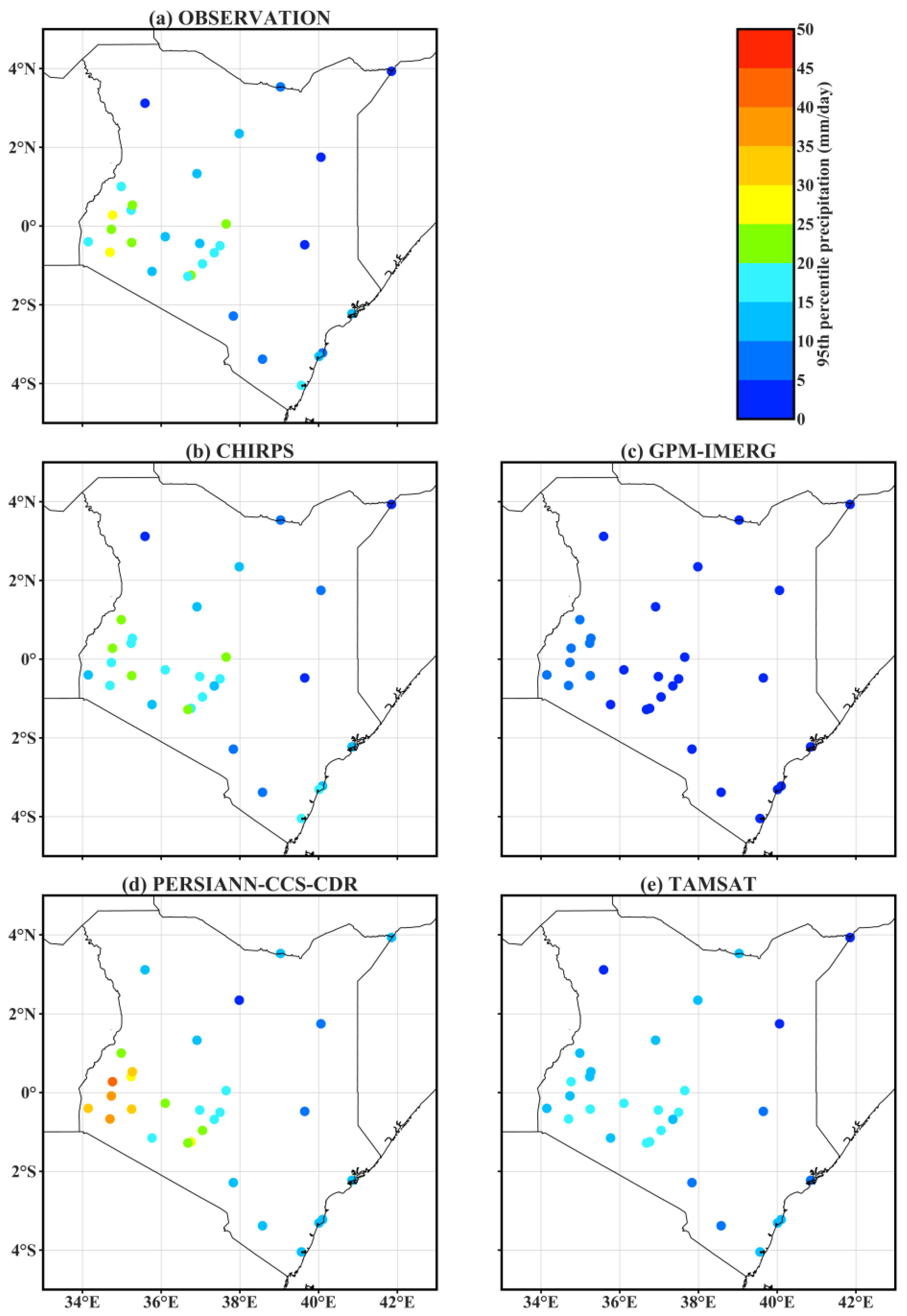
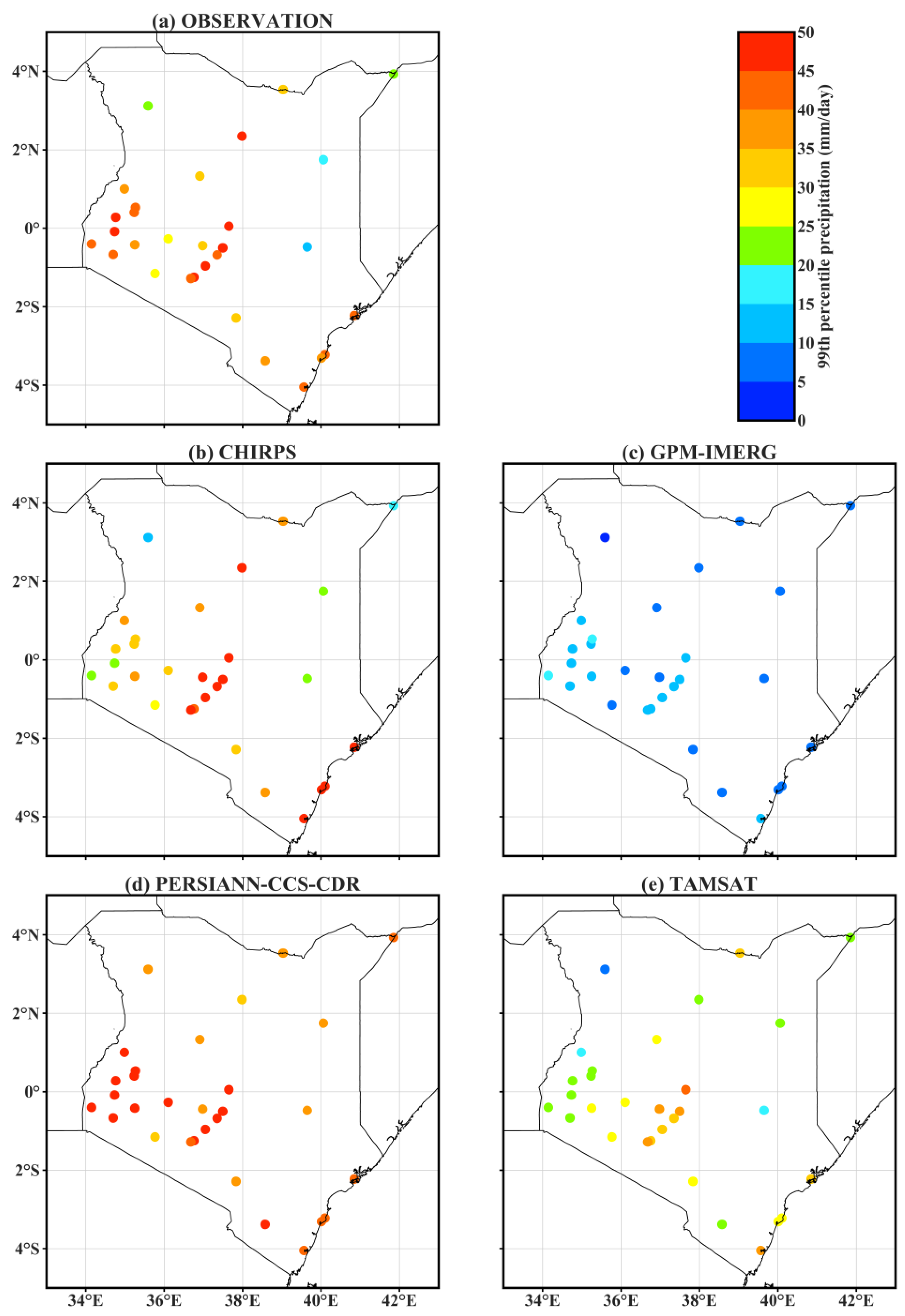
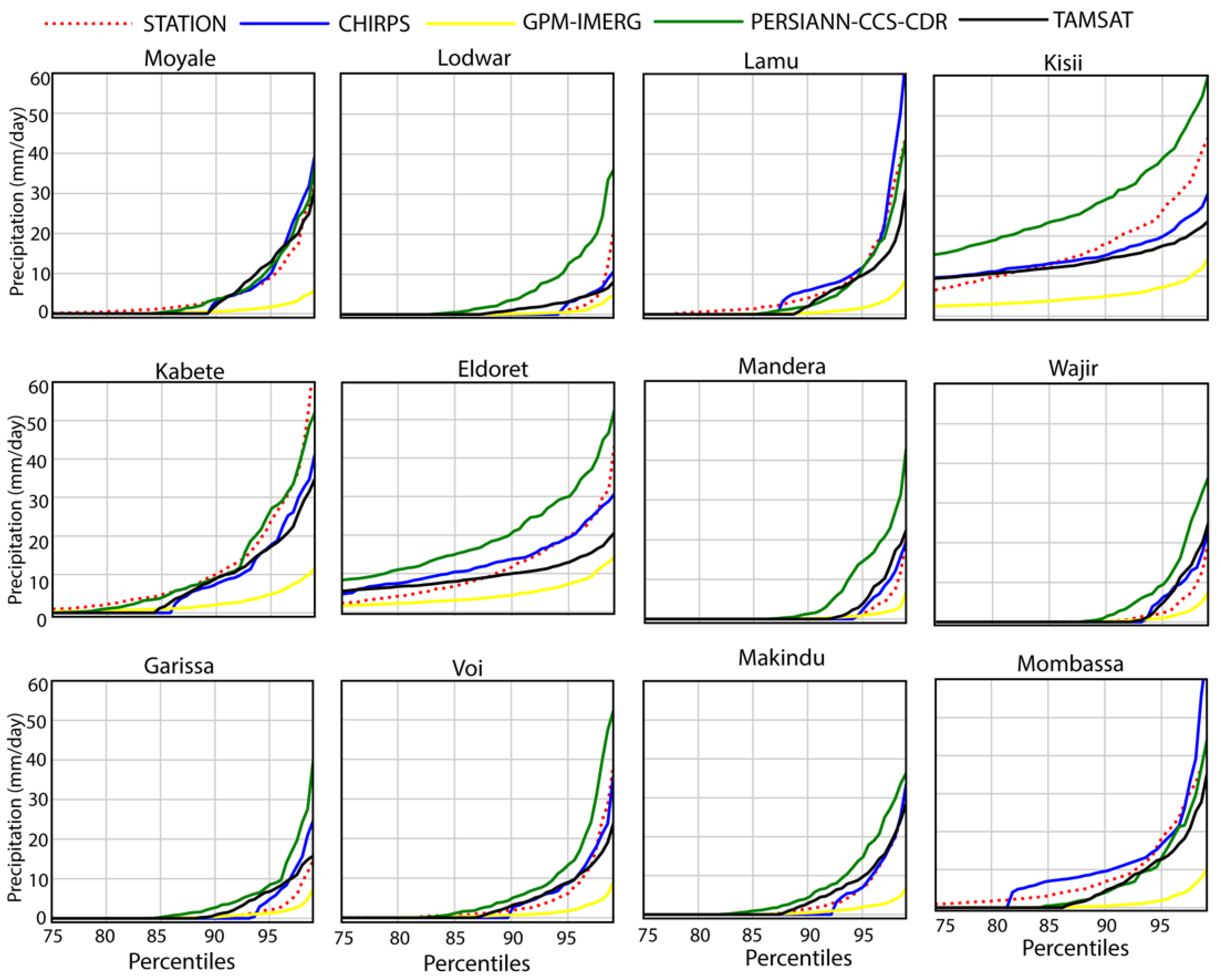

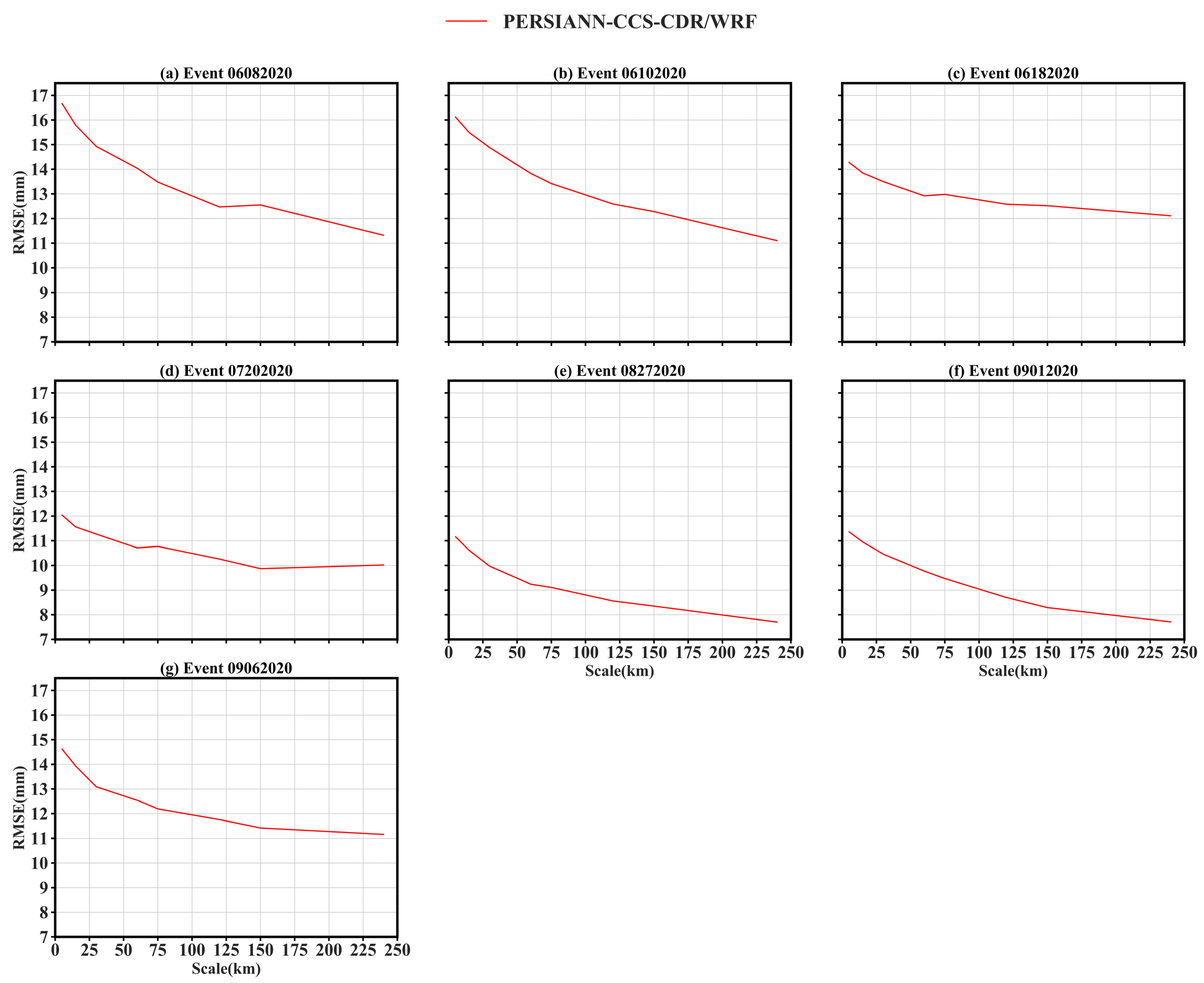
| Event Number | Occurrence Date | Different Events Simulations |
|---|---|---|
| Case 1 | 8 June 2020 | 18:00 7 June 2020 to 23:00 8 June 2020 |
| Case 2 | 10 June 2020 | 18:00 9 June 2020 to 23:00 10 June 2020 |
| Case 3 | 18 June 2020 | 18:00 17 June 2020 to 23:00 18 June 2020 |
| Case 4 | 20 July 2020 | 18:00 19 July 2020 to 23:00 20 July 2020 |
| Case 5 | 27 August 2020 | 18:00 26 August 2020 to 23:00 27 August 2020 |
| Case 6 | 1 September 2020 | 18:00 31 August 2020 to 23:00 1 September 2020 |
| Case 7 | 6 September 2020 | 18:00 5 September 2020 to 23:00 6 September 2020 |
| Model Settings | Parameterization Scheme | References |
|---|---|---|
| Microphysics | Lin et al. scheme | [59] |
| LW Radiation | RRTMG | [60] |
| SW Radiation | [61] | |
| Land Surface | Unified Noah Land Surface Model | [62] |
| Planetary Boundary layer (PBL) | Yonsei University Scheme (YSU) | [63] |
| Cumulus Parameterization | Grell 3D Ensemble Scheme | [64,65] |
| Surface Layer | MM5 similarity scheme | [66,67,68,69,70] |
Publisher’s Note: MDPI stays neutral with regard to jurisdictional claims in published maps and institutional affiliations. |
© 2022 by the authors. Licensee MDPI, Basel, Switzerland. This article is an open access article distributed under the terms and conditions of the Creative Commons Attribution (CC BY) license (https://creativecommons.org/licenses/by/4.0/).
Share and Cite
Nooni, I.K.; Tan, G.; Hongming, Y.; Saidou Chaibou, A.A.; Habtemicheal, B.A.; Gnitou, G.T.; Lim Kam Sian, K.T.C. Assessing the Performance of WRF Model in Simulating Heavy Precipitation Events over East Africa Using Satellite-Based Precipitation Product. Remote Sens. 2022, 14, 1964. https://doi.org/10.3390/rs14091964
Nooni IK, Tan G, Hongming Y, Saidou Chaibou AA, Habtemicheal BA, Gnitou GT, Lim Kam Sian KTC. Assessing the Performance of WRF Model in Simulating Heavy Precipitation Events over East Africa Using Satellite-Based Precipitation Product. Remote Sensing. 2022; 14(9):1964. https://doi.org/10.3390/rs14091964
Chicago/Turabian StyleNooni, Isaac Kwesi, Guirong Tan, Yan Hongming, Abdoul Aziz Saidou Chaibou, Birhanu Asmerom Habtemicheal, Gnim Tchalim Gnitou, and Kenny T. C. Lim Kam Sian. 2022. "Assessing the Performance of WRF Model in Simulating Heavy Precipitation Events over East Africa Using Satellite-Based Precipitation Product" Remote Sensing 14, no. 9: 1964. https://doi.org/10.3390/rs14091964
APA StyleNooni, I. K., Tan, G., Hongming, Y., Saidou Chaibou, A. A., Habtemicheal, B. A., Gnitou, G. T., & Lim Kam Sian, K. T. C. (2022). Assessing the Performance of WRF Model in Simulating Heavy Precipitation Events over East Africa Using Satellite-Based Precipitation Product. Remote Sensing, 14(9), 1964. https://doi.org/10.3390/rs14091964










